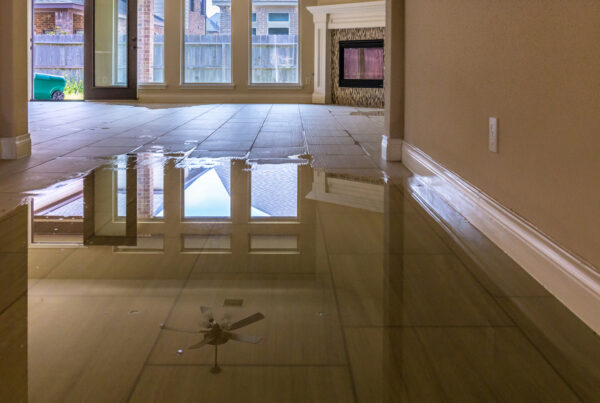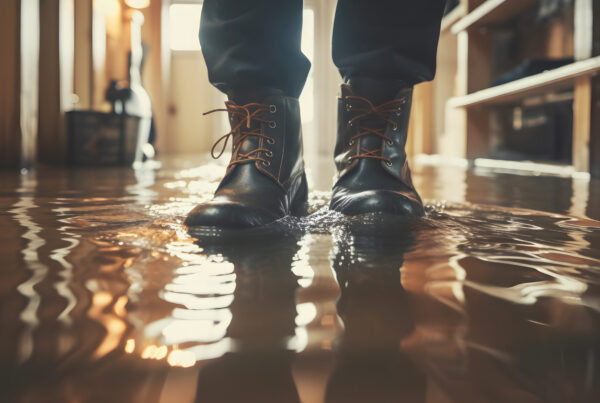Basements are a common addition to many homes in the Midwest thanks to our freezing-cold winters. Most home builders will build foundations below the frost line to prevent cracks and structural damage from frost heave, which can present new problems in the form of flooding. Many issues can cause a basement to flood, but if your basement flooded with sewage, that’s a severe problem best handled by the professionals. Before they arrive, it’s important to know how to respond to a basement flooded with sewage to minimize the damage to both you and your property.
Water in Basements
Since all or part of a basement is below ground, flooding is a common problem for homeowners. Water in basements can come from a variety of sources including:
- Heavy rainfall: Excess rainwater can seep through cracks in basement walls or overpower a sump pump.
- Burst pipes: Colder winter temperatures can cause pipes above the frost line to crack or burst.
- Sewage backup: If the main sewer line clogs, wastewater can enter the basement through a floor drain.
- Sump pump malfunction: Power outages, improperly installed pumps, or faulty check valves can all lead to water in a basement.
- Snow melt: Similar to rainwater, snow melt can overly saturate the soil around the foundation and seep into a basement.
When a basement flood occurs, it’s best to identify the source immediately since the remediation efforts are different based on the type of water involved: clear, gray or blackwater.
What Is Blackwater?
Blackwater is hazardous water that is contaminated with sewage, human waste, or chemicals. If the source of the basement flooding is the sewer line, this water will carry harmful bacteria, parasites and other pathogens, and present serious health risks.
When a basement floods with blackwater, take the following steps immediately to safeguard your family and get your property back to a healthy environment.
3 Steps to Take When a Basement Floods with Sewage
If you notice a foul smell or visible water around the drains in your basement, act quickly and take the following steps to mitigate the danger and damage:
- Safety first: Avoid direct contact with the sewer water. If you must enter the area, wear protective boots, gloves, eyewear, and a mask to avoid any serious health issues. Evacuate the basement and shut off the electricity and gas. Avoid flushing toilets.
- Call your insurance company: Your provider will recommend calling a plumber and a water damage restoration company immediately. When a basement floods with sewage, it’s critical to remove the contaminated water as quickly as possible and sanitize the affected area.
- Document the flood: Take photos of the affected area. These will help with filing an insurance claim and recovering the cost of repairs.
Basement Flooding Cleanup
The cleanup process can begin once the source of the water has been stopped by the plumber. Then the water remediation company will start the mitigation process, which typically includes these steps:
- Remove the water: Industrial-strength pumps and vacuums can quickly remove the contaminated water. A water mitigation technician is highly trained to handle sewer line backups and wastewater and can extract the water to avoid further damage to the area.
- Remove contaminated items: Any porous materials, such as carpeting, furniture, insulation and drywall that come in contact with sewer water must be removed. These items cannot be thoroughly cleaned after contamination and must be disposed of.
- Dry the area: Once the water is removed, the technician will install high-powered air movers and dehumidifiers to dry out the basement to prevent further damage and mold growth.
- Check for dryness: Thermal imaging cameras and moisture meters are used by the technician to ensure moisture levels return to normal.
- Sanitize: Only after the property is thoroughly dried will the technician treat the affected areas with an antimicrobial solution to eliminate bacteria and prevent mold growth.
Act Fast
Any basement flooding issue is a cause for concern, but sewage backups present an even greater risk. If this happens to you, it’s critical to move quickly but cautiously. If you live in the Twin Cities metro area, contact Restorations by Highmark immediately. Our water mitigation technician will begin working within an hour of your call. We offer 24/7 emergency response services for basements flooded with sewage and can quickly return your property to its pre-flood state.
For more tips on handling a flooded basement, read What to do When Your Basement Floods (and How to Prevent It).
Request a Free Inspection
If you suspect damage or need mitigation assistance, call our team right away. Our 24/7 mitigation team can be at your home within the hour if you live in the Twin Cities metro.








